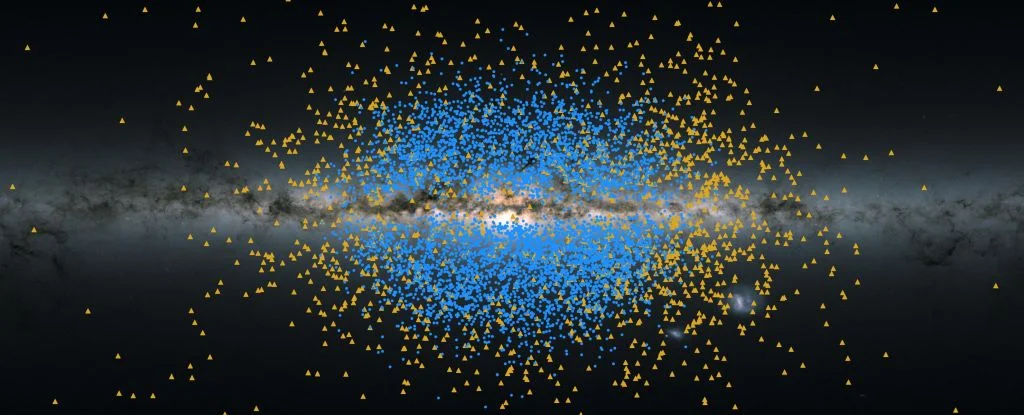Scientists find two early groups of stars in the Milky Way
- March 25, 2024
- 0
Shiva and Shakti – this is how astronomers called two ancient groups of stars in our galaxy. Judging by their parameters and motion, these are the remains of
Shiva and Shakti – this is how astronomers called two ancient groups of stars in our galaxy. Judging by their parameters and motion, these are the remains of

Shiva and Shakti – this is how astronomers called two ancient groups of stars in our galaxy. Judging by their parameters and motion, these are the remains of the first “brick” of the Milky Way, from a time when it had not yet acquired the form we are accustomed to.
One of the most interesting questions in modern astrophysics: How do massive galaxies form and evolve? As practice shows, we can get closer to the answer by examining the map of our native galaxy, the Milky Way. Such an opportunity for astronomers appeared not so long ago, since such large-scale studies require accurate data on the motion, age and other parameters of billions of stars. Based on these parameters, it is possible to determine how and in what orbits these objects were formed, whether they were born in the Milky Way or were connected to it in the process of merging with the Galaxy or a cluster.
When galaxies merge, each brings with it a source of hydrogen from which new stars begin to form in turbulent conditions. Over time, this “turmoil” slows down, the stars of the primary clusters mix with each other and with the young stars. The more time passes, the more difficult it becomes to isolate the components. For example, astronomers have just discovered that the Small Magellanic Cloud consists of two clusters.
Fortunately, some “vestiges” of the relatedness between the stars of individual clusters still survive. Especially the direction and energy of their movements. According to these parameters, scientists from the Max Planck Institute for Astronomy discovered two new substructures of the Milky Way in the data of the Gaia survey in a new study.
The age, metallicity, motion and orbits of stars in our galaxy are interconnected. The disk consists mainly of metal-rich stars in place , in the Milky Way. The luminaries participating in the merger process are located mainly in the Galaxy’s halo, which extends to tens of kiloparsecs. Among them, the “Gaia – Sausage – Enceladus” (GSE) group stands out, which are the remnants of a dwarf galaxy absorbed billions of years ago.
Astronomers also found a Splash population of metal-rich stars in the halo. Scientists have suggested that these stars formed in the disk of the Milky Way, but were ejected from there in the early stages during some kind of merger. In 2022, researchers identified an even older, metal-poor group of stars: the “Poor Old Heart” (POH) of the Milky Way.
To understand which of these groups the Milky Way’s new substructure objects are most similar to, the paper’s authors used data on the composition of stars from the Sloan Survey (SDSS). It turns out that both groups are poor in metals (astronomers call all elements heavier than the metals hydrogen and helium) and are poorer in properties than the oldest stars in the disk. These are more like “Poor Old Heart” stars than “bound” GSE stars.
After comparing the data, scientists concluded that these two substructures (Shiva and Shakti) are the remains of the first “brick” of the Milky Way. They joined more than 12 billion years ago, shortly before the formation of the galactic disk. All things considered, they were larger and more concentrated than the GSE. The results of the research were published in the journal Astrophysical Journal.
Scientists have identified about 1.7 thousand stars in Shakti’s substructure and about 5.6 thousand stars in Shiva. The total mass of each star is about 10 million solar masses. Researchers have also identified globular clusters in the outskirts of the Milky Way that may merge with Shiva and Shakti. By the way, the names are not accidental: these are the names of a pair of Hindu gods, whose union gave birth to our universe.
“It is surprising that we were able to distinguish these ancient structures. The Milky Way has changed so much since the formation of these stars, and we did not expect to separate them into groups. This was made possible thanks to the unprecedented data we received from Gaia,” said Khyati Malhan, lead author of the new study, explaining the uniqueness of the discovery.
Source: Port Altele
As an experienced journalist and author, Mary has been reporting on the latest news and trends for over 5 years. With a passion for uncovering the stories behind the headlines, Mary has earned a reputation as a trusted voice in the world of journalism. Her writing style is insightful, engaging and thought-provoking, as she takes a deep dive into the most pressing issues of our time.